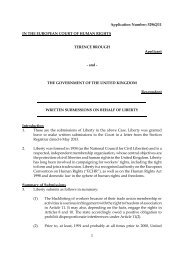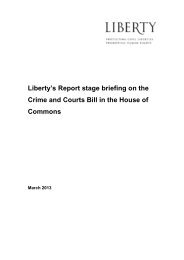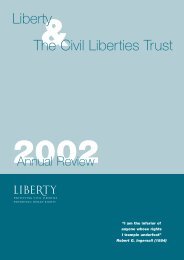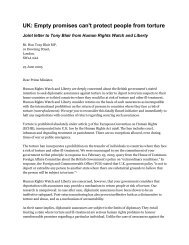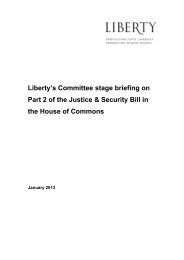Overlooked - Liberty
Overlooked - Liberty
Overlooked - Liberty
Create successful ePaper yourself
Turn your PDF publications into a flip-book with our unique Google optimized e-Paper software.
44 <strong>Overlooked</strong>: Surveillance and personal privacy in modern Britain<br />
evidence before individuals were apprehended, secure data retention, and operator training and<br />
supervision. Individuals should be protected by the need for consent for disclosure of images, and<br />
be able to obtain redress readily. With the exception of the evidence proposal, these are factors<br />
within the remit of the data protection regime, and to different degrees reflected in the existing code<br />
of practice. The new draft code, still at consultation stage, does seem to be attempting to<br />
strengthen and address some of these outstanding issues.<br />
Other regulatory options, that appear to be attractive to the public, are beyond the powers of the<br />
Information Commissioner, and the informational aspect of privacy, and appear to engage more<br />
directly with Article 8, and surveillance attributes. They go beyond the protection of individual<br />
interests and raise complex questions about the accountability of the public sector in the use of<br />
visual surveillance, and its role in monitoring other uses of visual surveillance. These options include<br />
a system of licensing, a role for local authorities in granting permission for the siting of cameras in<br />
public places, and consultation and participation by local people in the decision whether to install<br />
cameras and where to place them. Privacy or surveillance impact assessments may also have a role<br />
to play 97 . Such options are incapable of implementation without further public discussion and the<br />
development of consensus. Public awareness is needed to raise the level of debate, and a forum in<br />
which those responsibilities that fall outside the remit of the Commissioner, but engage Article 8, can<br />
be explored and refined.<br />
Three key questions emerge as we think of the future of visual surveillance technologies within the<br />
existing UK regulatory framework. The first is practical, and asks whether operators are meeting the<br />
requirements of the DPA, and maintaining signage, disciplined control rooms, and good data<br />
management and retention practice. The second encompasses the answer to that question, and<br />
asks whether the DPA is a sufficiently robust framework to enable the ICO to fulfil its role: “primarily<br />
to ensure that the Data Protection Principles apply in detail to the operation of surveillance in public<br />
places, and are seen to be properly and wholeheartedly enforced” 98 .<br />
The ICO lacks resources to build and promote its existing intervention, investigation and<br />
enforcement capacity, and can be expected to acknowledge that without general powers of<br />
inspection it is not possible to be confident that operators are complying with the legislation and<br />
code of practice. At European Union level, the Committee established to monitor the implementation<br />
of the EU Data Protection Directive 99 (the Directive upon which the Data Protection Act 1998 is<br />
based) is exploring what is needed for practical compliance, and seeking to harmonise compliance,<br />
has recognised that the ICO, along with its counterparts in other European countries, is underresourced.<br />
But the ICO also needs sufficient powers. The Committee’s call upon Member States to<br />
ensure that supervisory authorities take a more proactive step towards enforcement should add<br />
weight to this debate.<br />
The further question addresses imminent developments in the form of technological advances in<br />
surveillance methods and data sharing, and asks whether the DPA framework can or should be the<br />
only tool with which we meet the challenge as a society. The answer here appears to be that there is<br />
97<br />
A Report on the Surveillance Society, Surveillance Studies Network, ICO, 2006 where the potential of<br />
privacy and surveillance impact assessments are discussed in detail.<br />
98<br />
ICO, 2004<br />
99<br />
http://ec.europa.eu/justice_home/fsj/privacy/docs/95-46-ce/dir1995-46_part1_en.pdf




